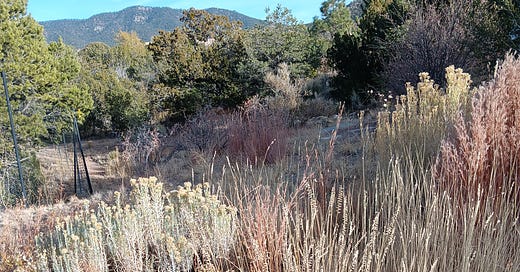On November 1, I left New England for New Mexico. Sky spit snow as I drove over Chesterfield Hill just 8 miles into my journey, then got serious about enfolding me in a snow squall as I scaled Hogback in Wilmington, VT. Four days later I got the first glimpse of the southern Rocky Mountains shining in the sun. There is no getting around it: New Mexico is a very long way away from New Hampshire. I could cite the mountain ranges, the number of miles, the number of hours, or the number of cups of coffee, but it is sufficient to say the drive carried me over a clear, sharp, definitive watershed. I left lands where water flows eastward into the Atlantic Ocean, I came to where water winds southward to the Gulf of Mexico. I left pain and anger, I arrived to sun, friends, and the frisson of joy this landscape always brings me.
The Earth in New Mexico is equally fantastic and alien to me. The very shape of this western land is a sharp contrast — a foil to those shapes inhabiting my life in the East.
Here, the Sangre de Christo mountains form the eastern wall for the Rio Grande River Valley rift at Santa Fe. The hills are blanketed in pinon/juniper forests and tumble together like spiky pillows tossed down and shoved together, overlapping, butting up against each other. Other peaks here are random volcanic cones or necks; there are buttes and mesas who look as if dumped here willy-nilly, left and forgotten by a massive child playing with shapes on the floor.
In contrast, New Hampshire mountains appear to emerge from the peneplain. Birthed by the shock of continental collision, squeezed and compressed, these ancient granite ranges were once taller even than the young Rockies are today. Wind and rain erode the land to humpbacked ridge lines — eons of weather sculpt the profiles of our mountains. Now we see the results of a mile high ice blanket, the most recent (at 12-14,000 years ago) geologic impact on the region. As the climate shifted, the glacier withdrew, retreated, melted northward, carving the softer soils and bedrocks away from the core granites. From that ice action, we are left with the gulfs, cirques, drumlins, and plutons of our landscape, smoothed as if the substrate was cake frosting molded with a spatula into the soft ridgelines punctuated with eye-releasing sheer screes or knife edged peaks. It feels deliberate. Lush vegetation and house-sized boulders inhabit the hills. Water is the fundamental element; the gestalt is Green.
New Mexico's landscape is a complex conglomerate of high desert plains, the infant Rocky mountains, a rift river valley, forests of dry pinon flung out like blankets over the land. Here all is sharp edged, gritty, with dry spikey needles, caltrops, spicules, sand. It feels abrupt. The rocks are slabbed along flat sheets rather than chunked or crystal-shattered-fractured, not softly water-worn. In this land, born of explosion or laid down by sediment, Wind and Sun are fundamental. The gestalt is Ocher.
Of course, I know how and why these landscapes are themselves — or at least I have done enough reading of those who have studied the rocks and observed the hills and ravines, canyons and rivulets, read the roadsides — but knowing origins does not mitigate the impact on my psyche and my very skin. New Hampshire and New Mexico: these two seemingly disparate environments both touch my essence.
I derive my strength from Earth. For my sixty years so far, that Earth has been the clay loam and boulders, the opulent wet green of New England. I came out here to this dry brown sandy-windy place to Be Here, to write, to think, to renew both spirit and intellect — to restore my soul and resume the work that was hijacked by false people. I can, I will, recover and reset from their disrespect to me (for they cannot touch my core), but their dishonor of the land is unforgivable. I know in my bones that they will receive, sevenfold from the universe, the damage they expel. They will drown in their own hate; I will draw up the power I receive from Earth, Sky, and Water. I reset, I renew, I thrive.
It is good to be here now.
Further reading about geology:
Chronic, Halka. Roadside Geology of New Mexico. Missoula, MT: Mountain Press. 1987/2000.
Davis, Nell. "MonadRocks: Mount Monadnock’s Fascinating Geologic History”. New Hampshire State Parks blog. Sept. 14, 2019. Retrieved from: https://blog.nhstateparks.org/monadrocks-mount-monadnocks-fascinating-geologic-history/
Perry, Joseph H. "Geology of Monadnock Mountain, New Hampshire". The Journal of Geology 12, no. 01. (Jan-Feb 1904). Retrieved from: https://doi.org/10.1086/621120




